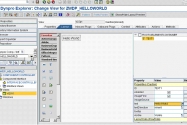![]()

Onlinewebdynprotraining.com, Bangalore
Karnataka India(IN)
: Institute
Write a Review Claim Your Ownership
The biggest online training provider in USA, UK is now providing world class training in India. Hurry up to sign up for free demos on ABAP, OOABAP, Web Dynpro ABAP and other technical and functional courses.
Check the details at onlinewebdynprotraining.com
or mail us at install.abap@gmail.com
We will provide free server access and study material with the course.
Course Details
Course
ABAP is a very high level programming language
created by the German software company SAP.
The ABAP programming language was originally used
by developers to develop the SAP R/3 platform. It was
also intended to be used by SAP customers to enhance
SAP applications – customers can develop custom
reports and interfaces with ABAP programming. The
language is fairly easy to learn for programmers but it is
not a tool for direct use by non-programmers. Good
programming skills, including knowledge of relational
database design and preferably also of object-oriented
concepts, are required to create ABAP programs.
ABAP remains the language for creating programs for
the client-server R/3 system, which SAP first released in
1992. As computer hardware evolved through the 1990s,
more and more of SAP's applications and systems were
written in ABAP. By 2001, all but the most basic
functions were written in ABAP.
Course Syllabus
SAP R/3 Fundamentals :
ABAP Dictionary Concepts
ABAP Programming Basics
Reports
Dialog Programs
File Handling
Enhancements
RFC
BAPI
Basics of Object Oriented ABAP
SAP R/3 Fundamentals :
ABAP Dictionary Concepts
ABAP Programming Basics
Reports
Dialog Programs
File Handling
Enhancements
RFC
BAPI
Basics of Object Oriented ABAP
SAP R/3 Fundamentals :
ABAP Dictionary Concepts
ABAP Programming Basics
Reports
Dialog Programs
File Handling
Enhancements
RFC
BAPI
Basics of Object Oriented ABAP
>Other Information
Course Fee: Not Mentioned
Course Duration: Not Mentioned
Placement Provided: No
Course Details
Course
In 1999, SAP released an object-oriented
extension to ABAP called ABAP Objects, along
with R/3 release 4.6.
Braking the barriers of classical ABAP and
module programming and coming into the world
of object orientation just like jumping from C to
C++. Here we talk about classes, objects,
inheritance, polymorphism, interfaces, abstract
classes, events and many more. Also to enrich
the conventional UI experience, you use SAP
control framework to design lucrative Ui’s using
ALV, Trees etc.
It uses the similar everyday principle: "If you
think in the same language which you want to
speak would be faster than the Thinking in the
native language and translating in Speaking
language".
The goal is to learn best programming practices.
Course Syllabus
Fundamentals of Object Oriented ABAP (2 days)
ABAP Runtime Type Service (1 day)
ABAP Control framework (3 days)
ABAP xml processing (1 day)
Doubt clarification and test (1 day)
>Other Information
Course Fee: Not Mentioned
Course Duration: Not Mentioned
Placement Provided: No
Course Details
Course
o In the long term, SAP Web Dynpro for ABAP will be
the successor of the traditional screen-based
("Dynpro") user interface technology which is based
on SAP GUI.
o Web Dynpro for ABAP or Web Dynpro for ABAP
(WD4A, WDA) is the SAP standard UI technology for
developing Web applications in the ABAP
environment. It consists of a runtime environment
and a graphical development environment with
special Web Dynpro tools that are integrated in the
ABAPWorkbench (SE80).
o Web Dynpro offers the following advantages for
application developers:
The use of declarative and graphical tools
significantly reduces the implementation effort
Reuse and better maintainability by using
components
Automatic data transport using data binding
which reduces the coding effort significantly
Automatic input checks
Completely based on object orientation.
Course Syllabus
Web Dynpro Introduction
Webdynpro Controllers
Context
User interface elements
Internationalization
Messages
Component Reuse
Dialog Boxes (Popups)
Faceless component
Adaptation Techniques
Dynamic Modifications at Runtime
Portal Integration
Integrating SAP Interactive Forms by Adobe
Floorplan Manager
Other Information
Course Fee: Not Mentioned
Course Duration: Not Mentioned
Placement Provided: No
- Atos IT Solutions and Services Pvt Ltd, Bangalore
- Tespa Infotech, Bangalore
- Tek Classes, Bangalore
- JK Initial Info Solutions Pvt Ltd , Bangalore
- Marks Solutions, Bangalore
- SAPTree Technologies Pvt Ltd, Bangalore
- InvenTech Info Solution Pvt. Ltd., Bangalore
- SAP Centre, Bangalore
- Koenig Solutions Pvt. Ltd., Bangalore
- SEED Infotech Pvt ltd., Bangalore
- NIIT Ltd, Bangalore
- KEYLABS TRAINING , Bangalore
- Lithan Genovate , Bangalore
- FIRST IDEAS, Bangalore
- Nidhi infotech, Bangalore
- Peopleclick Techno Solutions Pvt. Ltd., Bangalore
- IINT SIT (SAP Training /Corporate Training), Bangalore
- SAPTAC, Bangalore
- Discover Institute of Information Technology (DIIT), Bangalore
- Sreeram Online Training, Bangalore
- Onlinewebdynprotraining.com, Bangalore

